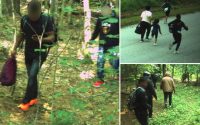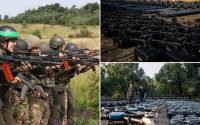Invasive plants fueling Maui wildfires: experts
Invasive highly flammable grasses in Hawaii have been key to fueling the deadliest wildfires in the US in more than 100 years, experts say.
While factors such as extreme weather events from climate change and the state’s local power grid have been blamed for helping to cause the blaze, large plots of land in Hawaii have been overrun by volatile non-native fire-prone grasses that are fueling the deadly flames, according to experts.
Land that was once occupied by irrigated pineapples and sugar cane was taken over by the grass species as those businesses began to decline, according to Elizabeth Pickett, the co-executive director of the Hawaii Wildlife Management Organization.
“The problem is at such a large scale, 26% of our state is now invaded by these grasses,” Pickett told The Associate Press.

“The landscape that has been invaded is steep, rocky and challenging to access. It’s a really hard landscape. You can’t just go with a lawn mower.”
As the invasive grasses burn, they ignite Hawaii’s native forests and threaten the homes of endangered species. The forests are then replaced by more of the pesky grass, Pickett noted.
The invasive grasses began dominating the island sometime after 2016, when Hawaii’s last sugar cane plantation on Maui shuttered, according to the New York Times.

The grasses — including guinea grass, molasses grass and buffelgrass — were brought to the islands from Africa as livestock forage and were considered effective because they proved drought-resistant, experts say. But their advantages have backfired.
“These grasses are highly aggressive, grow very fast and are highly flammable,” said Melissa Chimera, whose grandmother lived on the Hawaiian Commercial & Sugar Co.’s plantation in Maui after emigrating from the Philippines, to the Times.
“That’s a recipe for fires that are a lot larger and a lot more destructive,” said Chimera, who coordinates the Pacific Fire Exchange, a Hawaii-based project sharing fire science among Pacific island governments.
The grasses, which are fast-growing when it rains and drought-resistant when it’s drier, only persisted after wildfires spread across the islands in 2018.

At the time, Clay Trauernicht, a specialist in wildland fire science and management at the University of Hawaii at Manoa, sounded the alarm in a letter to the Maui News after the fires destroyed 21 homes.
“The fuels — all that grass — is the one thing that we can directly change to reduce fire risk,” he wrote.
While there are other contributing factors to such fires — including less rain in recent years — Trauernicht said the massive amounts of nonnative grasslands are at fault for the current wildfires.
“Yes many parts of Hawai’i are trending towards dryer conditions, BUT the fire problem is mostly attributable to the vast extents of nonnative grasslands left unmanaged by large landowners as we’ve entered a ‘post-plantation era’ starting around the 1990s,” Trauernicht wrote on X, formerly known as Twitter.


Two fires have not yet been completely contained as of Monday, including the one that reduced Lahaina’s neighborhoods to heaps of ash and debris, according to an update from Maui County.
The grim death toll is at 96 so far. Rescuers and cadaver dogs have gone door to door, searching the area for additional casualties. Only 3% of the historic town of Lahaina — the hardest hit area — had been searched.
Maui Police Chief John Pelletier said the fires have been so significant that each recovered body will have to be identified through DNA testing.
Hawaii officials are urging tourists to avoid traveling to Maui as many hotels are prepared to house evacuees and first responders.
With Post wires


